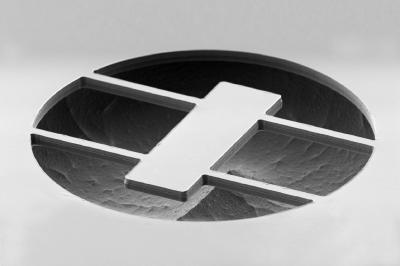From the wooden bars in a xylophone or the head of a drum, to the strings and sound box of a guitar or violin, musical instruments are the most familiar examples of mechanical resonators. The actual mechanical vibrations of these instruments create acoustic waves that we hear as sound. The purity of the emitted tone is intimately related to the decay of the vibration amplitude, that is, the mechanical losses of the system. A figure of merit for mechanical losses is the quality factor, simply called "Q", which describes the number of oscillations before the amplitude has decayed to a minute fraction of its starting value. The larger Q, the purer the tone and the longer the system will vibrate before the sound damps out.
In addition to the aesthetic examples found in a concert hall, mechanical resonators have become increasingly important for a wide variety of advanced technological applications, with such diverse uses as filtering elements in wireless communications systems, timing oscillators for commercial electronics, and cutting-edge research tools which include advanced biological sensors and emerging quantum electro- and optomechanical devices. Rather than producing pleasing acoustics, these applications rely on very "pure" vibrations for isolating a desired signal or for monitoring minute frequency shifts in order to probe external stimuli.
For many of these applications it is necessary to minimize the mechanical loss. However, it had previously remained a challenge to make numerical predictions of the attainable Q for even relatively straightforward geometries. Researchers from Vienna and Munich have now overcome this hurdle by developing a finite-element-based numerical solver that is capable of predicting the design-limited damping of almost arbitrary mechanical resonators. "We calculate how elementary mechanical excitations, or phonons, radiate from the mechanical resonator into the supports of the device", says Garrett Cole, Senior Researcher in the Aspelmeyer group at the University of Vienna. "This represents a significant breakthrough in the design of such devices."

Researchers at the University of Vienna and the Technische Universitaet Muenchen have solved a long-standing problem in the design of mechanical resonators: the numerical prediction of the design-limited damping. The electron microscopic picture shows one of their micro resonators with which they proved the performance of their calculations.
(Photo Credit: Garrett Cole, University Vienna)
The idea goes back to a previous work by Ignacio Wilson-Rae, physicist at the Technische Universitaet Muenchen. In collaboration with the Vienna group the team managed to come up with a numerical solution to compute this radiation in a simple manner that works on any standard PC. The predictive power of the numerical Q-solver removes the guesswork that is currently involved (e.g., trial and error prototype fabrication) in the design of resonant mechanical structures. The researchers point out that their "Q-solver" is scale independent and thus can be applied to a wide range of scenarios, from nanoscale devices all the way up to macroscopic systems.
Source: Technische Universitaet Muenchen